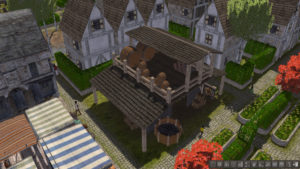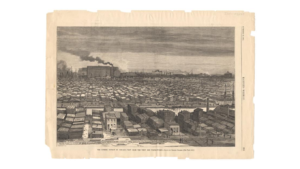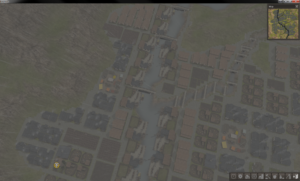At first glance, Banished feels pretty familiar for gamers who grew up playing things like Age of Empires. You start with a small stock of supplies and a few workers standing around in the wilderness. Your task is to efficiently convert that wilderness into a late-medieval settlement. I was initially excited about Banished because it seemed like a modern take on the kind of RTS I loved as a kid that just doesn’t seem to get made anymore. On closer inspection, though, it turns out to be only superficially similar. Banished has no armies, warfare, or even diplomacy. Instead, it’s more of a rural economy simulator, choosing what crops to plant and building barns and log cabins and making sure you have enough food to last the winter.
Playing the Frontier
I enjoy playing Banished well enough, but I’m always drawn back to it more for the potential and ambition of its premise than what the game actually is. At its core, the game tries to model the fundamental problem of human ecology: how to balance population, labor, and resources. Like all games, it has its simplifications and abstractions, but its depiction of the cycle of production, consumption, and demographic structure is remarkably direct and unadorned. The game doesn’t seem especially aware of the potential generalizability of its platform, however. Instead, it more closely evokes a historical archetype more mythical than ecological: the Taming of the Frontier.
When asked, Hodorowicz claimed that Banished takes place in no particular historical moment or real-world geography. The game itself, however, is full of signifiers of particular times and places, and they’re not particularly hard to read. The juxtaposition of wheat, cows, and chickens with corn, squash, and potatoes places it after the Columbian Exchange. The temperate climate and associated crops, along with the architecture and material culture–iron tools and coal fuel–strongly suggest Europe, but the absence of any other people in the landscape points to one of the colonial settings Alfred Crosby dubbed “Neo-Europes”: Argentina, New Zealand, South Africa, and especially eastern North America. It’s not surprising that the game’s most popular mod, Colonial Charter: New Frontier, makes the game’s colonial North American setting explicit. And while Colonial Charter includes plantation agriculture and sub-tropical bioregions, the base game, with its harsh winters, temperate vegetation, and mountainous terrain, most closely resembles early colonial New England. Therefore, I’ll be using New England (as covered in Diana Muir’s Reflections in Bullough’s Pond) as a historical point of reference for Banished’s economy.
The Plimoth Plantation Village in Plymouth, MA. Recreation of a 1627 village.
Banished’s empty wilderness, just waiting for European hands to bring forth its potential bounty, reflects a profound misunderstanding of American history. But that mistake is a deep part of America’s national identity, and something many people learn as fact. Before Columbus, the Americas were populated by an estimated 50-100 million people (comparable to Europe or Africa at the time) who shaped their environment profoundly with fire, hunting, agriculture, and monument construction. And while virgin soil epidemics of Eurasian diseases are estimated to have reduced North American population by up to 90%, the experience of early settlers was still defined by trade and conflict with Native Americans.
So while the mechanics in Banished model one of the most fundamental and general human experiences, they present only a small and somewhat fictionalized version of that problem. With large maps and no competitors, games play out under conditions of constant growth–there’s always more timber, more stone and iron to dig up, more rivers to fish, more land to farm. And unlike many of the historical simulation games it might be grouped with, technology is static. There are no “ages” to advance through, no technology tree to develop. It’s a snapshot of the imagined moment when hard work carved out a living from a landscape rich in potential but at the moment still a hostile wilderness.
“Labor, Which is Dear”
For all its mythologies and myopias (some reasonable, others problematic), Banished captures the logic of that historical moment in its central systems. While at first blush, the game’s main challenge–don’t let your population growth exceed your food supply–feels Malthusian, the turning point in Malthus’ equation (when population exceeds carrying capacity) is hard to reach. Most villages fail early, when the map is still covered in mushrooms, berries, deer, and fish, just waiting to be harvested. It is a shortfall of labor, not resources, that drives death in Banished. A temporary shortage of food, firewood, or tools can all cause death spirals: as villagers begin to starve or freeze to death, their absence makes it increasingly hard to recover the necessary supplies, no matter how much food might be left in the fields.
Conversely, as long as you have the labor, you can always increase production, a point the mechanics emphasize in several ways. Food and timber occur in the wild but in lower densities than in crop fields and timber plantations. Both harvesting and processing stations can be staffed with varying numbers of workers. The game suggests an optimum, and while going above that value will yield diminished marginal returns, it is possible to increase yield by increasing labor, within some limits. This logic of intensification follows a correction Esther Boserup made to Malthus’ formula. For humans, Boserup argued, population growth can provide for its own needs by intensifying food production per unit of land. Of course, there are physically limits to that intensification–historically it has held true, but because of a massive influx of fossil energy, not in the strict labor:yield relationships Boserup had in mind. However, it is a very relevant description of colonial agricultural economics.
During the colonial period, Europe was dense with people and sparse in natural resources. Manufactured goods were relatively cheap, while natural resources requiring unmanaged landscapes, like furs, large trees for ship masts, and bark for tanning leather, were expensive. But upon arriving in America, colonists experienced a sudden reversal of the familiar press for land. George Washington articulated the novelty: “The aim of farmers in this country is, not to make the most from the land, which is or has been cheap, but the most of the labor, which is dear.”
That land-labor relationship meant that production was extensive–only selling the biggest, highest-value trees, for instance, and wasting much of the rest–and made no use of techniques European farmers used to maintain the value of their farmland. Spreading manure, fallow periods, and crop rotation were luxuries labor-starved Yankee farmers couldn’t afford. Fortunately, in Banished there are quite literally no negative consequences of deforestation and intensive agriculture–stocks of land, fish, and deer are limited, but not exhaustible. Soil fertility doesn’t need to be maintained, and yield retains a constant relationship to labor. Despite its harsh man vs nature living-on-the-edge framing, it’s hard to overstate just how forgiving the environment in Banished is–trees leave no stumps to be cleared for farmland, wild animals don’t eat crops, and mills can be powered by standing water.
But if yield doesn’t fall over time, that just puts off the inevitable problems that come when population nears the capacity of the land to support it. (While it is relatively easy to stabilize population at or before that point, given the game’s themes, we can take the accessibility of population control as more about managing growth rate than achieving a limited population per se). This is the moment when the relationship between land and labor is inverted, and the challenges of managing production change. I’ve never reached this point myself–I don’t have the patience to get that far. In my experience, things quickly lost tension and interest after I was out of the desperate early days and my labor pool was large enough to cover emergency shortages. Banished, I concluded, was about frontier scarcity and growth, and anything that happened after that wasn’t really part of the design.
The Colonial Charter Mod tries to address this issue, adding a tremendous variety of manufactured goods, as well as the raw materials and processing structures necessary to produce them. Building their complicated and expensive production chains provides a medium term goal, but unlike most items in the base game, they don’t supply any pressing demand–they’re solutions without problems. The mod thus allows a kind of historical roleplay, almost a boutique economy, but it doesn’t in itself address the issue of meandering late-game economic challenge.
An authentic colonial-period winery, at home in any coastal tourist city.
Plowing the Fields of International Markets
So in the first draft of this piece, I ended on the conclusion that Banished was an effective model of the Colonial frontier economy, but that its late game play foundered because it showed no interest in the way the economic challenges changed as land was exhausted and labor became plentiful. Hodorowicz expressed uncertainty that the game would even run with most of the map in production, so I was confident in dismissing anything that might happen late in a game when land was scarce as outside the game’s problem space.
Before finishing up and sending off that first draft, though, I went to the Banished subreddit and asked if anyone knew what happened when you filled up the map. I wasn’t surprised to learn that plenty of people had achieved this feat of persistence, but I was a bit surprised by what they had to report. Trade is a pain in the ass in Banished, with traders arriving irregularly and infrequently, stymying attempts to set up a regular flow of goods. Using trade to solve a shortage in the early game is an exercise in futility; if you haven’t solved it yourself by the time the trader comes, you’ve probably lost anyway. In the mid game, they don’t really even carry large enough loads to be worth relying on. But apparently, through an elaborate process of building trading ports, manually placing requests for small loads of goods, and waiting for them to accumulate until trade volume is meaningful, it is possible to make trade a viable basis of the economy.
As land becomes scarce, then, low-value land uses were forced out and more and more land-intensive raw materials are acquired through trade. Eventually, to survive in a high-density map, players have to shift to a processing-only economy, importing things like fruit, wool, and iron and exporting wine, coats, and tools. The fact that the easiest way to achieve this in Banished is by importing logs and exporting hand-chopped firewood suggests that the game doesn’t have a particularly realistic cost of shipping, but that’s a question of calibration.
The commercial lumber yards and shipping canals of 1800s Chicago.
The wood cutting lots and shipping canals of Urbania IV.
Extreme self-sufficiency is a central part of the frontier myth Banished seeks to recreate. The historical economy of New England, however, was driven more by demands for a British quality of life and the manufactured goods that it relied on than by the productivity limitations that obtain in Banished. Colonists weren’t just trying to stay warm and fed; they were trying to do whatever they could to get enough money to afford British imports. Conversely, the British government saw the colonies as a market for British exports–a place where British companies could sell goods without competition from foreign manufacturers–making the colonies a captive market and driving up the amount of furs, timber, and grain they had to scrounge up to buy their cloth and tin. While players in Banished make choices based on building a surplus to survive the next winter, colonists in New England were strongly influenced by European (and Caribbean) markets.
Interestingly, while Hodorowicz doesn’t seem to have planned for a late game economy, its patterns that emerge mirror the historical role of international demand more directly than the more explicitly designed early game. As land prices increased and farm yields declined in New England, and particularly as populations grew to the point that sons could no longer inherit large enough chunks of farmland to make a living, excess labor was devoted to other kinds of work. Farmers and their wives made combs, furniture, and shoes by candlelight in the winter months. The shoe industry was a particularly successful trade, and New England went from an exporter of leather to a net importer as it grew. Soon thousands of people were doing piecework at home, shipping loads of shoe parts off to be assembled by other workers and sold by still others. This is the moment where Banished stops, when many people were working in manufacturing but the technology for mechanized production didn’t exist (though the Colonial Charter mod does follow a few industries to their logical next step: water-powered mills).
From the perspective of Banished’s clipped map, this shift from farming to manufacturing can be thought of as farming external demand instead of land. Despite its inconveniences, trade in Banished has its own unrealistic benefits. Prices are permanently fixed and demand is infinite, so there’s no risk that the market for your exports might collapse due to competition. And there are plenty of forces active in this scenario that Banished doesn’t touch on–most importantly, migration. The pressure to open land held by Native Americans and protected by the British contributed to the tensions that led to the Revolutionary War. But overall, it’s remarkable how well Banished’s late game economy fits the historical progression of frontier economic development in Colonial New England. It’s a testament to the robustness of Hodorowicz’s model, and hints at its potential as a template for games set in systems even more distant from the vaguely mythical frontier it tackles.





I submit to you, Tinytown.
https://www.reddit.com/r/Banished/comments/5j9hmc/welcome_to_tinytown_housing_optional/
Now in its 60th year, this experiment breaks game logic concerning population controls by forcing infertile couples out of their homes so that their children may bring about the next generation in their parent’s beds.
I’ve no idea what historical analog this has, there’s more Arkansas hillbilly than New England going on here.